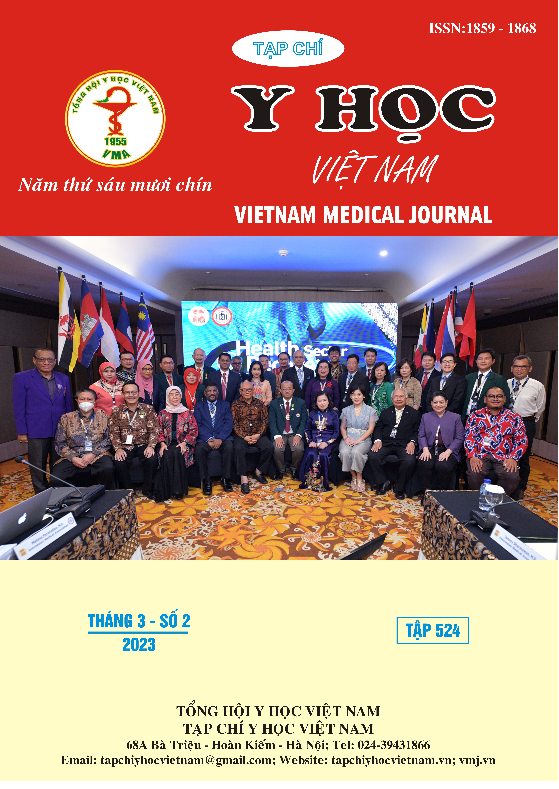CORRELATION BETWEEN BONE TURNOVER MARKERS AND BONE MINERAL DENSITY IN THE ELDERLY WOMEN
Main Article Content
Abstract
Objectives: To investigate the levels of serum OC and β-CTX, and the correlation between the levels of serum OC and β-CTX with bone mineral density (BMD) in elderly women. Methods: This cross-sectional study was conducted with the participation of 91 elderly women (≥ 60 years of age) at the Rheumatology and Geriatrics outpatient clinics, University Medical Center Ho Chi Minh City from November 2021 to April 2022. The data in both groups included demographics, complete blood count, biochemical markers, serum OC, serum β-CTX, and BMD by the DEXA method. Results: The levels of serum OC and β-CTX in elderly women with osteoporosis (OC: 21.9 [17.2 – 28.1] ng/ml; β-CTX: 0,593 [0,408 – 0,806] ng/ml) are higher than in the non-osteoporotic group (OC: 13.6 [10.5 - 20.1] ng/ml; β-CTX: 0,362 [0,281 – 0,500] ng/ml), p < 0.001. Serum OC concentration is moderately negatively correlated with BMD at the femoral neck (r = -0.45, p<0.001) and at the lumbar spine (r = -0.39, p<0.001). Serum β-CTX concentration is weakly negatively correlated with BMD at the femoral neck (r = -0.33, p = 0.001) and at the lumbar spine (r = -0.39, p<0.001). The cut-off values of serum OC and β-CTX concentrations for the diagnosis of osteoporosis are 17.6 ng/ml AUC = 0,78 [0,67 – 0,87], (sensitivity: 71.7%, specificity: 73.68%) and 0.447 ng/ml (AUC = 0,75 [0,63 – 0,84], sensitivity: 69.81%, specificity: 71.05%), respectively. Conclusion: Serum bone turnover markers (OC and β-CTX) levels in the osteoporotic group are significantly higher than in the non-osteoporotic group. The levels of serum OC and β-CTX are negatively correlated with BMD at the femoral neck and the lumbar spine. These turnover markers therefore would be potentially used to screen for osteoporosis in elderly women.
Article Details
Keywords
osteocalcin, β-CTX, bone mineral density, osteoporosis, elderly women
References
2. Trần Văn Đức, Lê Văn An, Nguyễn Hải Thuỷ (2017), “Nghiên cứu mối liên quan giữa osteocalcin và CTX huyết thanh với mật độ xương trong dự báo mất xương và điều trị loãng xương ở đối tượng phụ nữ trên 45 tuổi”, Tạp chí Y Dược học – Trường Đại học Y Dược Huế, 7 (5), tr.126-131.
3. Botella, S., Restituto, P., Monreal, I., et al (2013). Traditional and novel bone remodeling markers in premenopausal and postmenopausal women. The Journal of clinical endocrinology and metabolism, 98(11), E1740–E1748.
4. Greenblatt, M. B., Tsai, J. N., & Wein, M. N. (2017). Bone Turnover Markers in the Diagnosis and Monitoring of Metabolic Bone Disease. Clinical chemistry, 63(2), 464–474.
5. Gurban, C. V., Balaş, M. O., Vlad, M. M., et al (2019). Bone turnover markers in postmenopausal osteoporosis and their correlation with bone mineral density and menopause duration. Romanian journal of morphology and embryology = Revue roumaine de morphologie et embryologie, 60(4), 1127–1135.
6. Hendrijantini, N., Alie, R., Setiawati, R., et al (2016). The correlation of bone mineral density (BMD), body mass index (BMI) and osteocalcin in postmenopausal women. Biology and Medicine, 8(6), 319.
7. Mečevska-Jovčevska, J., Šubeska-Stratrova, S., Gjorgovski, I., et al (2009). Bone turnover markers relations to postmenopausal osteoporosis. Journal of Medical Biochemistry, 28(3), 161-165.
8. Vs, K., K, P., Ramesh, M., & Venkatesan, V. (2013). The association of serum osteocalcin with the bone mineral density in post menopausal women. Journal of clinical and diagnostic research: JCDR, 7(5), 814–816.


